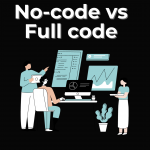Low-code and no-code development platforms represent a transformative shift in the world of software creation, offering powerful tools and methodologies that enable individuals and organizations to build applications with increased speed and reduced complexity. These platforms are designed to streamline the application development process, making it accessible to a broader audience, from business professionals to citizen developers, without the need for extensive coding expertise.
Low-code platforms provide a middle ground between traditional coding and no-code platforms. They offer a visual development environment and pre-built components that simplify application development while still allowing for more customization and flexibility than pure no-code solutions.
How can we describe a no-code development platform differently?
A no-code development platform is a revolutionary software environment that enables individuals to create sophisticated applications and software solutions without the need for traditional coding skills. These platforms leverage a visual interface and pre-built components, transforming the software development process into a more accessible and democratized endeavour.
No-code platforms offer several distinct advantages. First, they provide a drag-and-drop interface that allows users to design user interfaces, define data models, and establish workflows visually. This eliminates the need for manual coding, making application development more accessible to a broader audience.
Moreover, no-code platforms offer a library of pre-built components, templates, and widgets. These ready-made elements expedite development by offering functionalities like forms, databases, authentication systems, and integrations. Users can seamlessly integrate these components into their projects, saving time and effort.
No-code platforms also empower users to automate complex processes and define business logic without coding. Workflow automation capabilities enable the creation of intricate workflows, while decision-making logic can be configured effortlessly.
In addition, these platforms support integration with various data sources, third-party services, and APIs. This connectivity enables users to harness external data and services, enhancing the functionality and usefulness of their applications.
In conclusion, no-code development platforms are transformative tools that democratize software development. Their visual interfaces, pre-built components, and accessibility empower individuals and organizations to create applications and software solutions efficiently, promoting innovation and accelerating project delivery.
How can you go about crafting an application without engaging in the traditional coding process?
Building an application without writing traditional code has become a reality thanks to the emergence of no-code and low-code development platforms. These platforms empower individuals and organizations to create software applications using visual interfaces and pre-built components, making the development process more accessible to non-technical users.
No-code platforms provide a simplified and intuitive approach to application development, allowing users to design user interfaces, define data structures, and create complex logic through visual tools, all without the need for programming expertise. This democratization of app development opens doors for creative problem-solving and innovation across various industries.
Define Your Idea and Goals:
– Outline the key features and functionalities you want to include in your app
Choose the Right No-Code Platform:
– Research and select a suitable no-code or low-code development platform based on your project’s requirements, complexity, and budget.
– Some popular no-code platforms include Bubble, Adalo, OutSystems, and Microsoft Power Apps.
Plan Your Application:
– Create a detailed plan or storyboard that outlines the user experience (UX) and user interface (UI) of your application.
– Consider user flows, wireframes, and design mockups to visualize the app’s layout and navigation
Design Your Application:
– Use the platform’s visual design tools to create the UI of your application.
– Customize the look and feel of your app by selecting templates, fonts, colours, and styles.
– Add images, icons, and other graphical elements to enhance the design.
Define Data Structures:
– Determine the data structures and databases your application will use.
– Create data models, tables, or collections to store and manage data.
– Set up relationships between different data entities if needed.
Build Functionalities:
– Leverage pre-built components, widgets, and actions provided by the no-code platform to add functionality to your app.
– Customize and configure these components to match your specific requirements.
– Implement features such as forms, user registration, data retrieval, and data manipulation.
Set Up Logic and Workflows:
– Define the logic and workflow of your application using the platform’s visual tools.
– Create automation rules, validations, and triggers to control how the app responds to user interactions.
– Set up conditional logic for dynamic behaviour.
Testing and Quality Assurance:
– Thoroughly test your application to ensure that all functionalities work as intended.
– Identify and fix any bugs or issues.
– Conduct usability testing to gather feedback on the user experience.
Data Integration:
– If your app requires integration with external services, use the platform’s integration capabilities to connect to APIs, databases, or third-party tools.
– Configure data synchronization and communication with external systems.
Security and Compliance:
– Implement security measures to protect user data and application functionality.
– Ensure compliance with relevant data protection and privacy regulations.
User Experience Optimization:
– Optimize the user experience by refining the app’s design and usability based on user feedback.
– Perform performance testing and optimization to ensure the app runs smoothly.
Documentation and User Training:
– Create user documentation or tutorials to guide users on how to use your application.
– Provide customer support and training resources as needed.
Deployment and Publishing:
– Publish your application to the desired platforms, such as web hosting, app stores, or cloud services.
– Follow the platform-specific guidelines for deployment.
Marketing and Promotion:
– Develop a marketing strategy to promote your application and attract users.
– Use digital marketing, social media, and other channels to reach your target audience.
Feedback and Iteration:
– Continuously gather user feedback and monitor the performance of your application.
– Make iterative improvements and updates to address user needs and enhance functionality.
Maintenance and Support:
– Provide ongoing maintenance and support to ensure the reliability and stability of your application.
– Address any issues or bugs promptly.
What are the positive aspects of employing no-code solutions?
No-code development platforms offer several distinct advantages that make them a valuable tool for a wide range of users, from business professionals to entrepreneurs and even experienced developers looking to streamline certain tasks. Here are some of the key advantages of no-code development:
Accessibility:
No-code platforms are designed to be user-friendly and accessible to individuals with little to no coding experience. This democratizes software development and allows non-technical users to participate in creating applications.
Speed:
No-code development significantly accelerates the application development process. Users can create prototypes and deploy functional applications in a fraction of the time it would take with traditional coding.
Cost-Efficiency:
By eliminating the need for extensive coding and development resources, no-code platforms reduce development costs. This is particularly beneficial for small businesses, startups, and organizations with limited budgets.
Empowerment:
No-code platforms empower individuals and teams to take control of their software needs. Business professionals can create tools and solutions tailored to their specific requirements, reducing reliance on IT departments.
Rapid Prototyping:
No code allows for quick and easy prototyping of ideas. Users can experiment with different concepts and iterate rapidly to find the best solution.
Reduced Maintenance:
No-code platforms often handle maintenance tasks such as security updates, hosting, and scalability, reducing the burden on users to maintain and support their applications.
While no-code development offers numerous advantages, it’s important to recognize that it may not be suitable for every type of application or project. Highly specialized or complex applications may still require traditional coding. However, for many use cases, no-code development represents a powerful and accessible approach to application creation and innovation.
What are the drawbacks or limitations associated with no-code development?
While no-code development platforms offer numerous benefits, they are not without their drawbacks. It’s essential to understand the disadvantages and limitations of using no-code to build applications. No-code’s ease of use and accessibility come with trade-offs that can impact certain aspects of application development. In this series of articles, we will explore the disadvantages of no-code development in detail.
No-code platforms, which enable users to create software without traditional coding skills, have gained popularity for their ability to democratize application development. They empower individuals and businesses to build applications quickly and efficiently, reducing the need for extensive programming knowledge. However, there are several disadvantages to consider:
Limited Customization:
No-code platforms provide pre-built components and templates, which can restrict the level of customization available. For complex or highly specialized functionalities, it may be challenging to achieve the desired level of customization. Users are often confined to the capabilities and design patterns provided by the platform, limiting their ability to implement unique or intricate features.
Scalability Challenges:
While some no-code platforms offer scalability options, they may not be suitable for large-scale or resource-intensive applications. Performance and scalability can be limited due to the platform’s abstractions and constraints. As applications grow in complexity and user load, they may encounter performance bottlenecks that require more extensive coding or platform migration.
Vendor Lock-In:
No-code platforms are often proprietary, which can result in vendor lock-in. Applications built on a specific platform may rely heavily on its proprietary features and technologies, making it challenging to switch to alternative solutions. This lack of portability can limit flexibility and long-term adaptability, potentially affecting the sustainability of the application.
Security Concerns:
Security features and compliance capabilities on no-code platforms may be limited compared to traditional development approaches. Users must be diligent in ensuring that their applications meet security standards and data protection regulations. In some cases, the platform’s security mechanisms may not align with specific industry requirements, necessitating additional customization or integration with third-party security tools.
Dependency on Updates:
Users rely on the platform provider for updates, bug fixes, and security patches. Delays in updates or platform issues can impact the stability and security of applications. Users are dependent on the platform’s maintenance and support practices, which may not always align with their specific needs or timelines.
These disadvantages highlight important considerations when using no-code development platforms. While these platforms offer accessibility and speed advantages, users should carefully assess their project requirements and evaluate whether the limitations of no-code align with their goals and constraints. In some cases, a hybrid approach that combines no-code with traditional coding may provide a more robust solution.
Concluding Remarks
In conclusion, no-code development platforms have ushered in a new era of accessibility and speed in software creation. These platforms empower individuals and businesses to build applications without the need for extensive coding expertise, democratizing the world of software development. By providing visual interfaces, pre-built components, and simplified workflows, no-code platforms enable users to bring their ideas to life quickly and efficiently.
The advantages of no-code, including accessibility, speed, cost-efficiency, and user empowerment, are clear. They have the potential to revolutionize the way businesses operate and how individuals turn their innovative concepts into reality. No-code’s role in fostering collaboration, accelerating time-to-market, and encouraging a user-centric approach to development cannot be underestimated.
However, it’s essential to acknowledge the disadvantages of no-code as well. Limited customization, scalability challenges, vendor lock-in, security concerns, and dependency on updates are factors that users must carefully consider when choosing this approach. No-code may not be suitable for all types of projects, especially those that require highly specialized or complex functionalities.
Ultimately, the decision to use no-code or traditional coding depends on the specific requirements and goals of each project. For many use cases, no-code represents a powerful and accessible approach to application development, enabling innovation and rapid iteration. However, for more complex or highly customized endeavours, a hybrid approach that combines no-code with traditional coding may provide the best of both worlds.
In this evolving landscape of technology and development, the versatility of no-code platforms continues to expand, offering new opportunities and challenges. Whether you’re an entrepreneur, a business professional, or a creative thinker, embracing the possibilities of no-code can be a game-changer, enabling you to bring your ideas to life and make a meaningful impact in the world of software and technology.





















